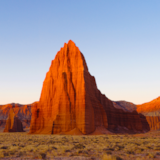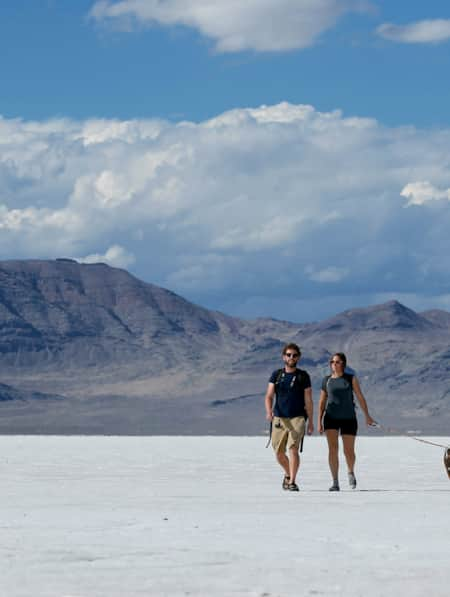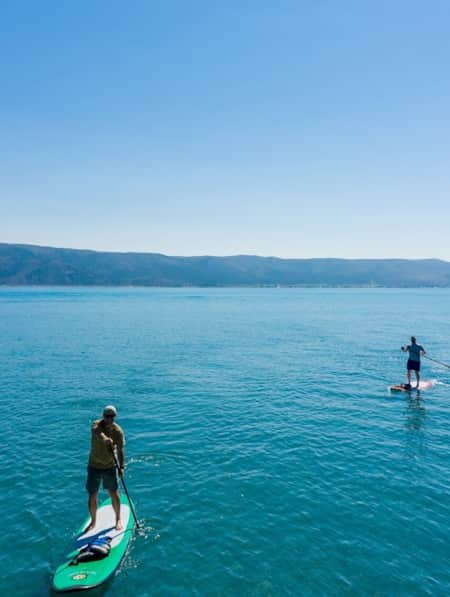Tooele? Tuilla? The Fascinating History of this Utah Town
And One of Utah's Original Counties

A land of ancient settlements, pioneers, missiles and race cars, the Utah town of Tooele rests along the shores of the Great Salt Lake just 34 miles from Salt Lake City and boasts history and landmarks aplenty. But for Utah locals, how you pronounce this town’s name is a dead giveaway of one thing: You’re not from around these parts.
So let’s get the vernacular straight first. Tooele is not pronounced Too-LEE or Too-ELL as the spelling suggests but Too-WILL-a. Adding to the confusion, the county was first spelled Tuilla but changed to Tooele in 1852 when Deseret’s boundaries (a precursor territory to today’s Utah) were extended to California. Today, folks are still arguing about where the name originated.
Some think it’s taken from the native Goshute Indian word for "bear," while others say it’s a corrupted spelling of “tule,” a common weed that grows in swampy areas of this valley. Regardless of who’s correct, this agrarian community has grown up since its founding, expanding from 1,200 residents at the turn of the century to more than 33,000 people today.
The curious case of Tooele’s name is only a small piece of this town’s fascinating past.
"The Tooele Valley was the site of some of North America’s oldest human settlements."
Ancient Peoples
Did you know the Tooele Valley was the site of some of North America’s oldest human settlements? Danger Cave, an excavated site between Wendover and Tooele, features artifacts like fabric, twine, basket shards, plants, and tools made from bone and wood — some dated to 11,000 years ago. Metcalf Archaeological Consultants and the Utah Division of Parks and Recreation have partnered to provide limited public tours of Danger Cave. Each tour is limited to 25 people, and the cost is $18 for adults and $12 for children ages 8-15.

The Great Salt Lake has always been a big attraction in Tooele County.
Photo: Emily Sierra
First Residents
Long before pioneers settled the valley, nomadic bands of Goshute Indians made this desertscape their home. Living off the land, the Goshutes resided in wickiups — round shelters built from brush — and created clothing out of woven plants and rabbit skins. As pioneers homesteaded the region, native numbers declined, but some descendants of this band still reside on a reservation in Tooele County’s Skull Valley.
An Inland Sea and the Great Salt Lake
Thousands of years ago Tooele County was deep under the waters of ancient Lake Bonneville, and today it’s a gateway to its salty remnant — the Great Salt Lake. As you drive along Interstate 80, stop to explore the United States’ largest salt lake at Black Rock or Great Salt Lake State Park Marinas. Recall the lake’s tourism heyday at nearby Saltair, a 20th century resort where people came by trains to "Bob Like a Cork" in the saline waters.
Remnants of the Past
First incorporated in 1853 and named county seat by 1861, Tooele City boomed as Mormon settlers found lush pastures for livestock. During this time, pioneers constructed cabins, sawmills and buildings that remain visible today, including what’s hailed as the most significant historical structure between Salt Lake City and Reno, the Benson Grist Mill. Built more than 150 years ago to process wheat and corn, the mill’s rock base still stands and the wooden frame has been restored to its former glory. Step inside to see the old milling equipment or hop on a bike to ride a 14-mile loop that surrounds the mill.
The small town of Ophir offers historical sites as well. The community members of Ophir have created an outdoor museum to take you back in the past to what life was like in the late 1800's for this old mining town. Community members have moved historical artifacts to a central location for people to learn about and enjoy. Some of the historical artifacts include mining trains, mining equipment, reconstructed buildings, and a post office. Before you visit, check to make sure the buidlings are open. Typically, Saturdays are good days to visit as volunteers are working.
The Pony Express Trail
The legendary Pony Express Trail ran through Tooele County from 1860 to 1861, connecting Missouri to California in a multi-day relay race. Skinny boys younger than 18 raced across the country on this route, earning $25 a day for their long, arduous journey. Explore Tooele’s Pony Express backcountry byway and national historic trail to Simpson Springs Station, a reconstructed station house where riders would change places and horses to keep the mail moving along. (Read: What Hasn’t Been Found)
Mining Heyday
Mining transformed Tooele when the gold strike boosted the population to 5,000 by 1930, which drove the growth of railroads, smelting and refining companies. The seven-mile Tooele Valley Railroad was constructed in 1917 to connect a smelter on the town’s eastern side to the Union Pacific Railroad main line, allowing the industry to flourish for 55 years. On Tooele’s east side, "New Town" was founded as a home for 1,000 smelter workers and families from around the world who lived and attended school here, speaking a wide variety of foreign languages. Though the boom is over, many old, open mines remain but are (thankfully) being closed up due to their dangers, and Kennecott now operates the world’s largest smelter — located in Tooele County.
The Lost Colony of Iosepa
A group of Mormon Pacific Islander converts traveled all the way from Hawaii to establish the town of Iosepa in the remote desert near Tooele in 1889, remaining for 28 years before suddenly disappearing — instructed to return to Hawaii to help build a Temple in Laie. All that remains of this long-abandoned Hawaiian colony is a cemetery with a few hundred plots and a colorful town sign, which stands as a memorial to these early settlers who risked so much for a new life.
Weapon Testing and Race Car Driving
Wide-open desert made Tooele a perfect test site for the United State’s growing arsenal of chemical and biological weapons in the 1940s. The Dugway Proving Ground was the epicenter for the development and testing of new missiles and is still operated by the U.S. Army today.
Beyond western Tooele, the Bonneville Salt Flats line Interstate 80 and stretch flat and smooth for more than 30,000 acres between Tooele County and Nevada. The salt flats formed when Lake Bonneville dried up, and race enthusiasts now come to the Bonneville Speedway to race and make and break land speed racing records, sometimes exceeding 240 mph. Walk on this piece of history yourself at a beautiful stretch beyond Tooele, 10 miles from Wendover.
If you're interested in archery, the Deseret Peak Archery Range is open year round and is equipped with stable targets for your shooting convenience. The Archery Range is located at the Deseret Peak Complex and offers many events throughout the year, from rodeo to BMX to motocross to archery. The complex features something to satisfy every sport enthusiast’s hunger for excitement.
Reliving the Past
Tooele’s many museums memorialize everything from early settlers to locomotives to firefighting. Visit the Tooele Pioneer Museum to learn about the area’s Native American and early settler history, or the Tooele Valley Museum and Historical Park to see artifacts from the railway and mining era. And for something completely different, visit Tooele’s Utah Fire Museum on a Friday or Saturday for interpretive displays about firefighting in Utah and displays of 35 separate fire vehicles and devices.






